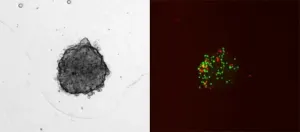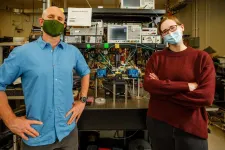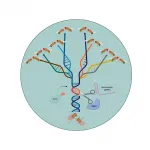Replicating patients' tumors to test different treatments
UNIGE Researchers have developed in vitro tumor models that incorporate components of the tumor and elements of the patient's immune system to test the effectiveness of treatments
2021-06-02
(Press-News.org) Every tumour is different, every patient is different. So how do we know which treatment will work best for the patient and eradicate the cancer? In order to offer a personalised treatment that best suits the case being treated, a team of scientists led by the University of Geneva (UNIGE), Switzerland, had already developed a spheroidal reproduction of tumours that integrates the tumour cells, but also their microenvironment. However, the immune system had not yet been taken into account, even though it can either be strengthened or destroyed by the treatment given to the patient. Today, the Geneva team has succeeded in integrating two types of immune cells that come directly from the patient into the spheroidal structure, making it possible to test the various possible treatments and select the most effective. These results can be read in the journal Cancers.
In order to test cancer treatments, scientists use 2D cultures of cancer cells. However, these are only an artificial system, as they do not represent the 3D tumour in all its complexity. This is why the team of Patrycja Nowak-Sliwinska, professor at the Section of Pharmaceutical Sciences of the Faculty of Science of the UNIGE, has developed a spheroidal structure that reproduces the microenvironment of the tumour. "The idea is to create a 3D structure from the cells of the tumour, while also integrating the fibroblasts - cells that make up the mass of the tumour - and the endothelial cells, which allow the tumour to feed and be vascularised." This method, which has since been used by the University Hospitals of Geneva (HUG), allows us to get closer to the tumour as it is present in the patient's body. "However, an important factor was still missing: the cells of the immune system", explains the Geneva researcher.
The critical role of the immune system in the fight against cancer
The immune system is the primary fighter against tumours and it reacts differently depending on the treatment prescribed to the patient: its effectiveness can either be increased or decreased. Today, the Geneva team, in collaboration with the universities of Lausanne and Amsterdam, has succeeded in integrating two types of immune cells into its spheroidal structure: macrophages and T lymphocytes. "This technological advance makes it possible to test the effects of a treatment not only on the tumour, but also on the immune system!", enthuses Magdalena Rausch, researcher at the UNIGE's Section of Pharmaceutical Sciences and first author of the study. To do this, the scientists first take cells from the patient's tumour to recreate it in vitro in the form of a spheroidal structure, and then they isolate the immune cells and inject them into the 3D structure. "Once this step has been completed, which takes 24 hours, we can test the various possible treatments for this cancer on our reproduction of the tumour and study which one will be most suitable for the patient, taking into account the effects on the tumour cells, but also on the immune system", explains Patrycja Nowak-Sliwinska.
This technique, which is relatively inexpensive and fast, would make it possible to propose a personalised treatment for each patient, while offering an effective alternative to several animal experimentations. "This platform opens up many possibilities for testing drug combinations, taking into account the different types of cancer, their mutations and the immune reactions specific to each person treated", concludes Patrycja Nowak-Sliwinska.
INFORMATION:
[Attachments] See images for this press release:

ELSE PRESS RELEASES FROM THIS DATE:
2021-06-02
The Permian Basin, located in western Texas and southeastern New Mexico, is the largest oil- and gas-producing region in the U.S. The oilfield operations emit methane, but quantifying the greenhouse gas is difficult because of the large area and the fact that many sources are intermittent emitters. Now, researchers reporting in ACS' Environmental Science & Technology Letters have conducted an extensive airborne campaign with imaging spectrometers and identified large methane sources across this area.
According to the U.S. Energy Information Administration, 38% of the nation's total oil and 17% of natural gas production took place in the Permian Basin in 2020. Therefore, quantifying emissions from these operations, which continue to expand rapidly, is ...
2021-06-02
A healthy diet around the time of conception through the second trimester may reduce the risk of several common pregnancy complications, suggests a study by researchers at the National Institutes of Health. Expectant women in the study who scored high on any of three measures of healthy eating had lower risks for gestational diabetes, pregnancy-related blood pressure disorders and preterm birth. The study was conducted by Cuilin Zhang, M.D., Ph.D., and colleagues at NIH's Eunice Kennedy Shriver National Institute of Child Health and Human Development (NICHD). It appears in the American Journal of Clinical Nutrition. ...
2021-06-02
A team of students working with Jonathan Boreyko, associate professor in mechanical engineering at Virginia Tech, has discovered the method ducks use to suspend water in their feathers while diving, allowing them to shake it out when surfacing. The discovery opens the door for applications in marine technology. Findings were published in ACS Applied Materials & Interfaces.
Boreyko has a well-established body of work in the area of fluid mechanics, including the invention of a fog harp and the use of contained, recirculated steam as a cooling device. As his research has progressed throughout the past decade, the mechanics of duck de-wetting has been one of his longest-running projects.
"I got this idea when I was at Duke University," ...
2021-06-02
Jack Tseng loves bone-crunching animals -- hyenas are his favorite -- so when paleontologist Joseph Peterson discovered fossilized dinosaur bones that had teeth marks from a juvenile Tyrannosaurus rex, Tseng decided to try to replicate the bite marks and measure how hard those kids could actually chomp down.
Last year, he and Peterson made a metal replica of a scimitar-shaped tooth of a 13-year-old juvie T. rex, mounted it on a mechanical testing frame commonly used in engineering and materials science, and tried to crack a cow legbone with it.
Based on 17 successful attempts to match the depth and shape of the bite marks on the fossils -- he had to toss out some trials because the fresh bone slid around too much -- he determined that a juvenile could have exerted ...
2021-06-02
ALBUQUERQUE, N.M. -- Scientists at Sandia National Laboratories have built the world's smallest and best acoustic amplifier. And they did it using a concept that was all but abandoned for almost 50 years.
According to a paper published May 13 in Nature Communications, the device is more than 10 times more effective than the earlier versions. The design and future research directions hold promise for smaller wireless technology.
Modern cell phones are packed with radios to send and receive phone calls, text messages and high-speed data. The more radios in a device, the more it can do. While most radio components, including amplifiers, are electronic, they can potentially ...
2021-06-02
Twice a day, at dusk and just before dawn, a faint layer of sodium and other metals begins sinking down through the atmosphere, about 90 miles high above the city of Boulder, Colorado. The movement was captured by one of the world's most sensitive "lidar" instruments and reported today in the AGU journal Geophysical Research Letters.
The metals in those layers come originally from rocky material blasting into Earth's atmosphere from space, and the regularly appearing layers promise to help researchers understand better how earth's atmosphere interacts with space, even potentially how those interactions help support life.
"This is an important discovery because we have never seen these dusk/dawn features before, and because these metal layers affect many things. The ...
2021-06-02
DALLAS, June 2, 2021 -- A "prescription" to sit less and move more is the optimal first treatment choice for reducing mild to moderately elevated blood pressure and blood cholesterol in otherwise healthy adults, according to the new American Heart Association scientific statement published today in the American Heart Association's journal Hypertension.
"The current American Heart Association guidelines for diagnosing high blood pressure and cholesterol recognize that otherwise healthy individuals with mildly or moderately elevated levels of these ...
2021-06-02
A large group of iconic fossils widely believed to shed light on the origins of many of Earth's animals and the communities they lived in may be hiding a secret.
Scientists, led by two from the University of Portsmouth, UK, are the first to model how exceptionally well preserved fossils that record the largest and most intense burst of evolution ever seen could have been moved by mudflows.
The finding, published in Communications Earth & Environment, offers a cautionary note on how palaeontologists build a picture from the remains of the creatures they study.
Until now, it has been widely accepted the fossils buried in mudflows in the Burgess Shale in Canada that show the result of the Cambrian ...
2021-06-02
CRISPR-based technologies offer enormous potential to benefit human health and safety, from disease eradication to fortified food supplies. As one example, CRISPR-based gene drives, which are engineered to spread specific traits through targeted populations, are being developed to stop the transmission of devastating diseases such as malaria and dengue fever.
But many scientists and ethicists have raised concerns over the unchecked spread of gene drives. Once deployed in the wild, how can scientists prevent gene drives from uncontrollably spreading across populations ...
2021-06-02
CHICAGO -- Women who experience acute aortic dissection--a spontaneous and catastrophic tear in one of the body's main arteries--not only are older and have more advanced disease than men when they seek medical care, but they also are more likely to die, according to research published online today in The Annals of Thoracic Surgery.
"Data over the course of the last few decades demonstrate differences in both presentation and outcomes between males and females who have acute aortic dissection, with greater mortality among females," said Thomas G. Gleason, MD, from Brigham and Women's Hospital in Boston, Massachusetts. "This study underscores ...
LAST 30 PRESS RELEASES:
[Press-News.org] Replicating patients' tumors to test different treatments
UNIGE Researchers have developed in vitro tumor models that incorporate components of the tumor and elements of the patient's immune system to test the effectiveness of treatments





